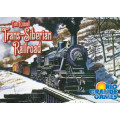Try to connect your rail lines from Moscow to Vladivostock while avoiding the Tsar.
Once the game has started, you may, each turn:
- Buy stock, specifically one share of one company or one share each of two different companies; the money paid is placed in the railroad's treasury, and when you buy two shares, you must pay an additional $4 to one of the two companies.
- Build links, especially one link, two links, or an external link (i.e., to a location on the border of Russia) - but only if the railroad is public (i.e., if at least two shares have been purchased) and if you own at least as many shares of that railroad as each other player. (If a railroad has had only one share purchased, it is private). ) You can build direct links that extend that railroad's existing network, or you can skip the links of another railroad to extend the network in a more convoluted way. When you build two links, the second link must begin where the first link built in this round ended. The cost of building an internal link is $4, and if you skip another railroad's links, you must pay $2 to that railroad's treasury; the cost of building an external link is $8, plus $4 to each railroad per link you skipped.
When you build a link, the value of that link - 2-6 - is added to that railroad's income. Each time a railroad's income marker lands or passes over a black mark on the income track, the value of that railroad's share is increased by one level. Also, when you build two links or an external link, the action value of that railroad is increased by one level.
- Pass.
When you buy two actions, build two links, build an external link, or pass, you move the timing token one space on the timing track. When that token reaches the end of the track, each railroad pays dividends to those who hold shares, with the railroad's income divided by the number of shares held, then rounded up. If Red has an income of $11 and you own two shares and another player owns one, then you receive $8 and the other player receives $4.
After dividends are paid (and the timing token is reset), if a railroad has a share value of at least $48, the game enters Phase 2, which begins with an auction for a share of the black and white railroads, with the winner of each auction claiming a non-external link for that railroad that connects to another railroad's network.
In Phase 2, after you have paid dividends, you check to see if a railroad's share value is equal to or less than the nationalization value, which starts at $24 and increases after each dividend payment in Phase 1, each failed auction of a railroad's share at the beginning of either phase, and each dividend payment in Phase 2 during which no railroad has been nationalized. If the value of a railroad's shares is less than the nationalization value, that railroad is nationalized, and each share owner receives a final dividend payment, after which all shares of that railroad are removed from play. Once all nationalizations are complete, the nationalization value is increased by three levels for each nationalization that has occurred.
If, at this point, a railroad has a share value of $75 or the Dividend Marker has reached the end of the track, the game ends; otherwise, players continue playing.
At the end of the game, players add up the value of the shares they hold in the public railroads with the money they have on hand. The player with the most money wins.
Copyright © 2025 www.philibertnet.com Legals - Privacy Policy - Cookie Preferences - Sitemap






